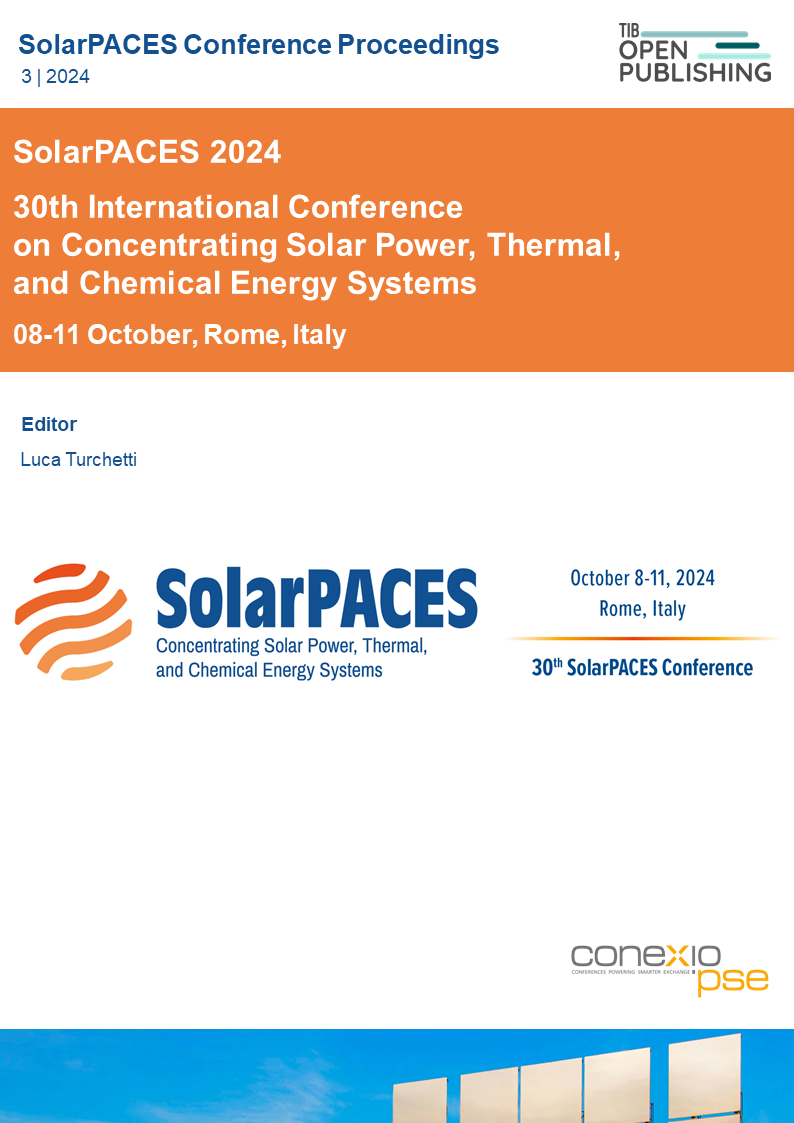Evaluation of Flow Patterns for Direct Steam Generation
DOI:
https://doi.org/10.52825/solarpaces.v3i.2370Keywords:
Direct Steam Generation, Process Heat, Two Phase FlowAbstract
In solar Direct Steam Generation (DSG) systems, steam is produced directly in the solar field instead of producing it in a steam generator. Liquid water is fed to the solar field and is heated as it flows through the absorber pipes until it starts to evaporate and a two-phase flow develops. The resulting two-phase flow can take various forms, such as slug flow or annular flow, depending on the vapor content and other influencing variables such as the mass flow through the absorber tubes. There are flow patterns that are unfavorable for the operation of a solar thermal system. In particular, a stratified flow with a high vapor content can lead to the formation of dry areas in the upper inner walls of the absorber tube. At these areas, the heat can no longer be sufficiently transferred to the liquid, so that the wall temperature rises and the tubes can become deformed leading to the breakage of the glass cover [1,2,3,4]. In addition, further mechanical loads can be added by the momentum inherent in the slug flow. The annular pattern is a particularly advantageous flow pattern for direct evaporation. In this case, the liquid flows as a ring along the wall through the absorber tube, while the vapor flows inside the liquid. This ensures that the heat is absorbed evenly by the liquid. In the Jordan Optimizing Solar Steam for Industry (JOSSI) project, a measurement campaign was carried out with the aim of recording the two-phase flow patterns within the horizontal absorber tubes and investigating their occurrence under different operating conditions.
Downloads
References
[1] Eck, M., and Hirsch, T., 2007, “Dynamics and Control of Parabolic Trough Collector Loops With Direct Steam Generation,” Sol. Energy, 81(2), pp. 268–279.
[2] Mokhtar, M., Zahler, C., & Stieglitz, R. (2022). Control of Concentrated Solar Direct Steam Generation Collectors for Process Heat Applications. Journal of Solar Energy En-gineering, 144(1), 011005.
[3] Mokhtar, M., Zahler, C., & Stieglitz, R. (2021). Experimental Investigation of Direct Steam Generation Dynamics in Solar Fresnel Collectors. Journal of Solar Energy Engineering, 143(5), 054504.
[4] Mokhtar, M. M. (2019). Control of solar thermal linear Fresnel collector plants in single phase and direct steam generation modes (Doctoral dissertation, Dissertation, Karlsruhe, Karlsruher Institut für Technologie (KIT), 2018).
[5] Berger, M., Mokhtar, M., Zahler, C., Willert, D., Neuhäuser, A., & Schleicher, E. (2017, June). Two-phase flow pattern measurements with a wire mesh sensor in a direct steam generating solar thermal collector. In AIP Conference Proceedings (Vol. 1850, No. 1). AIP Publishing.
[6] Collier, J.G.; Thome, J.R. Convective Boiling and Condensation, 3rd ed., reprint 2001 ed.; The Oxford Engineering Science Series; Clarendon Press: Oxford, UK; Oxford University Press: New York, NY, USA, 2001; p. 38
[7] Y. Taitel, A. E. Dukler. (1976), „A Model for Predicting Flow Regime Transitions in Hori-zontal and Near Horizontal Gas-Liquid Flow”, AlChe Journal (Vol. 22, No.1, pp. 47-54)
[8] C. Rouhani (1969), “Modified correlations for void and two-phase pressure drop”, AB Atomenergi. AE-RTV-841
Published
How to Cite
Conference Proceedings Volume
Section
License
Copyright (c) 2025 Navina Konz, Eckhard Schleicher, Mohammed Smeirah, Marwan Mokhtar, Dirk Krüger

This work is licensed under a Creative Commons Attribution 4.0 International License.
Accepted 2025-04-10
Published 2025-11-18
Funding data
-
Bundesministerium für Bildung und Forschung
Grant numbers 01LZ1803B
